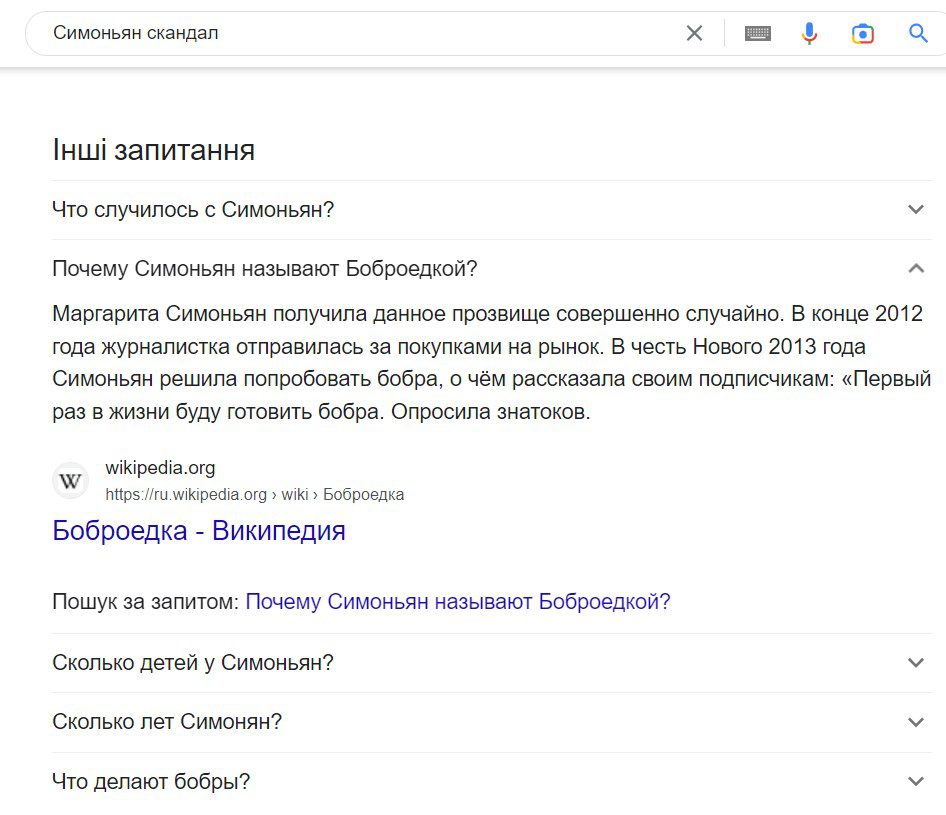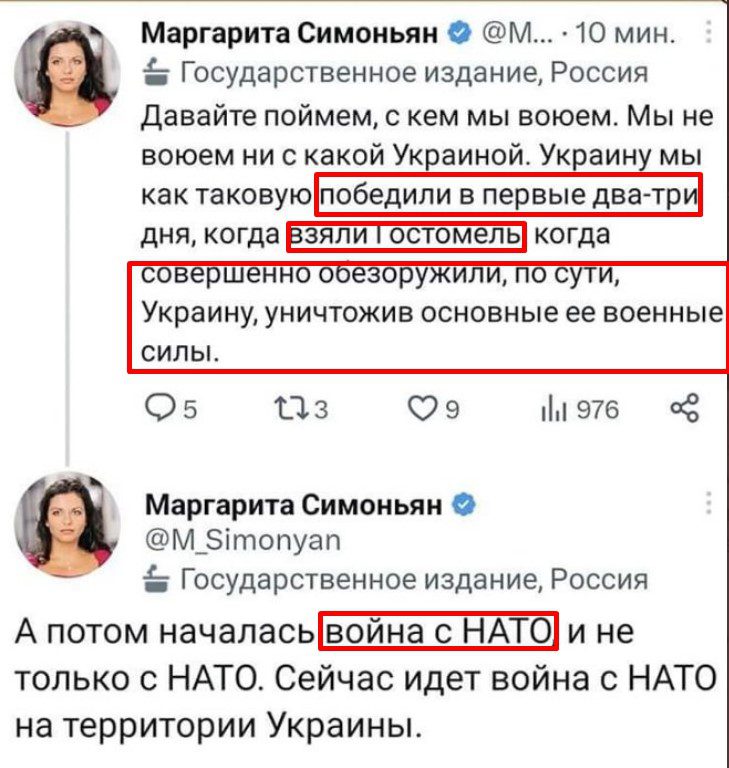Margarita Simonyan: A Profile with the Help of AI

Zaborona spoke to ChatGPT about what it knows about Margarita Simonyan. It turned out that, according to artificial intelligence (AI), one of Russia’s most influential propagandists is almost a luminary of journalism and a good, talented person whose merits are recognized by the world.
Why does AI produce such results? Who confused the machine? The reason is clear, and we will explain in fairly simple language and analyze with examples how the truth is being replaced.
There is such a gray term as SERM (Search Engine Reputation Management). It is called “gray” because it uses both fair and black methods. Depending on them, there is black SERM (for example, slandering a person or company on the Internet through bot farms) and white SERM (posting positive, truthful texts with facts, links, and evidence on authoritative websites).
Due to the dubious nature of their approaches, digital companies usually do not openly say that they are engaged in so-called whitewashing or blackening. We won’t reveal all the secrets, but after reading this article, you will be able to recognize at least the signs of such campaigns in the media.
Online reputation: what it is and how it works
Online reputation is what anyone (and now anything) sees when they search for a company/term/event/person on Google or another search engine.
Using SERM, a brand’s reputation is manipulated and has a positive or negative impact on the audience. Before making a purchase, for example, people usually google
- what other consumers say about the brand or product;
- what scandals have occurred;
- how convenient it is to get it if we choose it (payment method, delivery, nearest stores, photos/videos).
As for people, we also “buy” them to a certain extent: we vote, support (and promote ideas/products), listen or watch (we popularize them, and the artist receives related benefits), donate, etc. So, everything that people see about us on the Internet influences their choice: to work or not, to believe or not.
SERM is multidimensional, as it includes PR, social media and content marketing (ORM), as well as SEO. Let’s take a closer look:
- PR — public relations, activities that are visible to the target audience. In fact, this is the whole point. Public events, publications in the press, advertising — all these are means to promote the desired product to the masses.
- ORM is online reputation management. It includes shadowy ways of influencing the audience on the Internet: telegram channels and publics on social networks, blogs, work with reviews, and bot farms. The maximum attention is paid to those with URL links that can be found through a search engine.
- SEO — everything is simple: you need to set up the site so that the reader feels comfortable (quickly browse pages, easily download data and read/view content), and search engines like Google love it for useful information and the same comfort for the reader. (After all, a reader = an advertising consumer, and Google is actually the largest distributor of advertising in the world).
The fact is that 90% of users don’t go beyond the first or second page of Google results. The tech giant is improving its algorithms so that users don’t waste time and nerves searching for answers to their queries. Therefore, the page that has the most accurate and complete information on a person’s request is in the lead.
For popular and not new queries, the highest-ranking sites will be those with a long history and more relevant answers. The results depend on your location, the interface language of the device you are using, and your search history: Google will most likely show the sites you visit most often (if there is an answer there, of course).
AI’s job is to “vacuum” the search results, analyze the data, and give results almost based on the principle that “millions of flies can’t be wrong.”
So now it’s easy to understand why Margarita Simonyan looks white and fluffy to AI: because tens of thousands of resources write like this. Moreover, this cohort includes many verified resources with very high traffic.
Artificial intelligence has no ethics or morals and does not analyze whether a website is a propaganda, whether the text is written to order, and whether it is true. After all, SERM requires several well-thought-out strategies that involve all possible resources and tools.
Obviously, the work on sowing positive information about Margarita Simonyan has been going on for a long time and with high quality. Russian propagandists have at their disposal all online resources, search engines, and social networks. If not, you are considered a foreign agent.
Here’s a typical page (the first page of results) on a website with a long history: the tag shows all texts that mention Margarita Simonyan.

They even correct Wikipedia.

What happened to Simonyan?
Why is Simonyan called a beaver eater?
A beaver eater – Wikipedia
Margarita Simonyan received this nickname quite by accident. At the end of 2012, the journalist went shopping at the market. In honor of the New Year 2013, Simonyan decided to try the beaver, which she told her subscribers about. “For the first time in my life, I will cook a beaver.”
By the way, pay attention to the block of tips that Google places on the first page of the search results. You can work with them too. If you have the resources, it’s quite easy: you place texts with the necessary keywords/hint queries on the grid of sites (for example, “Why is Simonyan called Beaver eater”), then engage bots that regularly kill this query. After a while, the search engine believes that this information is extremely popular, and voila: Margarita Simonyan is called a beaver eater by an unfortunate accident!
Russian propagandists are dangerous, in particular from a technical point of view, because they are well-versed in copywriting and use their social networks (see the point about ORM) to sow the necessary messages through keywords. Which, of course, will be in all Internet search engines. Here is a vivid example.

Let’s understand who we’re fighting. We are not at war with any Ukraine. We defeated Ukraine as such in the first two or three days, when we took Hostomel, when we completely disarmed Ukraine, destroying its main military forces.
Margarita Simonyan
And then the war began with NATO, and not only with NATO. Now there is a war with NATO on the territory of Ukraine.
Qualitative work with queries (highlighted in the screenshot) is aimed at two goals:
- to tell a different “truth” to the domestic consumer by manipulating keywords;
- to encourage Ukrainians and other compassionate users to spread the story on the Internet.
The propagandists do not have to impose such narratives on Ukrainians (the enemy knows perfectly well that this is impossible and does not waste energy on it), but someone will definitely take the bait, which will raise the search results in the network that has no borders.
In this way, the necessary information will be seen and consumed by those who, for example, believe that “not everything is so clear,” are against NATO and do not see Russians as enemies, etc.
Margarita Simonyan’s biographical data: Zaborona vs. AI
We conducted an experiment: we asked ChatGPT about Margarita Simonyan’s biography. The fact-checking showed that AI is not wrong: the propagandist has been whitewashed for years using SERM, replacing the truth with what is necessary. See for yourself:
Simonyan family
AI. Margarita Simonyan was born on April 6, 1980, in Moscow, her father was an ethnographer and her mother was a journalist.
Zaborona.In fact, the Russian propagandist was born in Krasnodar, not Moscow. There is virtually no information about her family in the public domain, and there is no evidence that her father was an ethnographer and her mother a journalist. Some websites with Margarita Simonyan’s biography only mention that her father’s name is Simon Sarkisovich and he was probably engaged in repairing refrigerators, and her mother, named Zinaida, sold flowers in the market.
Where did she study?
AI. She graduated from the Moscow State University of Culture and Arts, where she studied the theory and practice of journalism.
Zaborona. In fact, she graduated from the Faculty of Journalism at Kuban State University in Krasnodar. Before that, she studied at the Vladimir Posner School of Television.
Work at Russia Today
AI. In 2005, she joined the team of journalists that founded the RT TV channel. Later, she became the head of RT’s editorial office in Russia, and in 2014 she became the editor-in-chief of the international news agency Sputnik.
Zaborona. Margarita Simonyan has been the editor-in-chief of Russia Today since its founding in June 2005. In 2013, she was appointed editor-in-chief of the newly created Rossiya Segodnya international news agency, while retaining her position as head of the channel. In November 2014, she also became the head of another propaganda media outlet, Sputnik, meaning that she held three leadership positions at the same time.
Margarita Simonyan in world rankings
AI. Simonyan was included in the list of “100 Women of the World” by the British magazine The Guardian.
Zaborona. The Guardian, which compiled the Top 100 Women ranking in 2011, has never included Margarita Simonyan in it. Instead, in 2017, she was ranked 52nd in Forbes’ list of the world’s most powerful women. In 2018, the Russian propagandist was removed from the list.
What films has she made?
AI. In 2010, she premiered her documentary The Terminal, about life and work at Sheremetyevo Airport. The film won several awards at international film festivals.
Zaborona. There is no documentary with this title, which was supposedly released in 2010. And, accordingly, it did not receive any international awards. Margarita Simonyan has never directed a film, but in 2018 she wrote a script for the propaganda film ‘Crimean Bridge. Made with Love’, directed by her husband Tigran Keosayan.
Is Simonyan an activist?
AI. Margarita Simonyan is a member of the board of the Right to Life Foundation, which is one of the leading Russian organizations dedicated to protecting the rights of unborn children and supporting family values. In particular, she has participated in organizing and supporting the foundation’s social campaigns that promote “life as the highest value” and fight against abortion.
Zaborona. There are several charitable foundations in Russia called “Right to Life” (“Право на жизнь”). However, there is no evidence from open sources that Margarita Simonyan is in any way connected with their activities. The propagandist herself has also never declared her participation in such organizations.
Attitude to freedom of speech
AI. She believes in the importance of freedom of speech and media independence, but at the same time defends Russia’s position in the international arena and promotes pro-Russian views.
Zaborona. In fact, Margarita Simonyan is an active supporter of total censorship of the Russian media environment. In particular, on April 10, 2022, on the air of an evening talk show with Vladimir Solovyov, she stated that “a great state cannot exist without control over information.” According to her, there were two periods in Russian history when there was no censorship: from 1905 to 1917 and during Gorbachev’s perestroika. These periods were followed by the collapse of empires. That is why she insists that to protect the Russian Federation from such a fate, it is necessary to introduce strict censorship.
Accusing Simonyan of spreading propaganda
AI. Some critics believe that RT and its journalists, including Simonyan, are spreading propaganda in favor of Russia, in particular through biased reporting and focusing on negative news about Western countries. However, there are also other views that RT can help balance the dominant Western media landscape and give a voice to alternative points of view.
Zaborona. The fact that Margarita Simonyan is one of the main mouthpieces of Russian propaganda is recognized by dozens of countries around the world, including EU members and the United States. According to the State Department, throughout her career, she has been promoting the Kremlin’s narratives about the events in Beslan, the Russian invasion of Georgia, and the Russian-Ukrainian war. American experts have found that Simonyan is a protégé of Alexei Gromov, Putin’s first deputy chief of staff. She even has a special phone at home for direct secure communication with the Kremlin, as the propagandist herself admitted in 2015.
Simonyan on social media
AI. Simonyan is an active user of social networks, including Twitter, where her profile has more than 840 thousand followers.
Zaborona. The Russian propagandist is indeed active on Twitter, but as of March 10, 2023, she has 543.8 thousand followers (we can assume that this is the result of a bot sweep after Elon Musk bought the microblogging service). On Telegram, her own channel has an audience of more than 477 thousand subscribers (also relevant as of 10.03.2023).
What books has she written?
AI. She is the author of the book ‘Superhumans: Revelations of RT’s Editor-in-Chief’, which tells the story of her professional experience and principles of journalism.
Zaborona. The book with this title has never been published in Russia or any other country in the world. Instead, Simonyan is the author of other books, including the pseudo-patriotic novel ‘To Moscow!’ and the collection of short fiction ‘Black Eyes’.
Margarita Simonyan’s influence abroad
AI. Simonyan has been an active advocate for the Russian diaspora abroad, particularly during the conflict in Ukraine and the crisis in eastern Ukraine, but this also raises questions about her objectivity and possible influence on the minds of the Russian community abroad.
Zaborona. In fact, Margarita Simonyan actively uses all the Kremlin’s means to spread propaganda and disinformation abroad, both for Russians and citizens of other countries. Because of this, the EU imposed personal sanctions against her in 2014, and since March 2022, it has banned RT and Sputnik from its territory. The United States, the United Kingdom, Canada, Australia, Japan, and other countries have also imposed restrictive measures against Simonyan and her channels.

